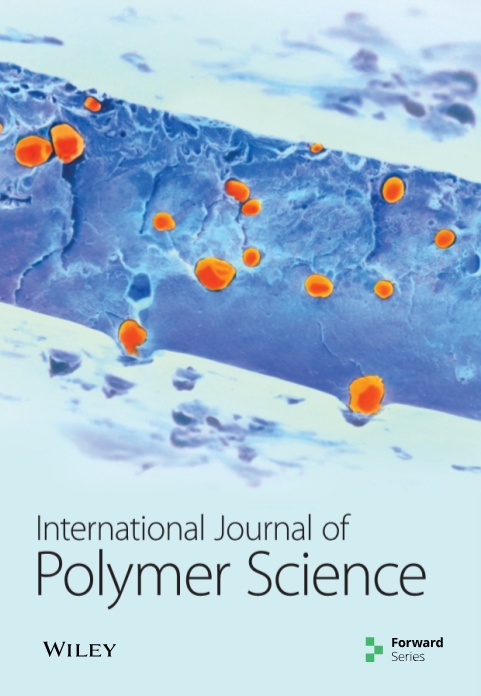Investigating the Effect of Curing Activators on the Cure Kinetics of Acrylonitrile–Butadiene Rubber Filled with Graphene Oxide and Reduced Graphene Oxides Nanocomposites
IF 4.4
4区 化学
Q2 POLYMER SCIENCE
引用次数: 0
Abstract
For the first time, acrylonitrile–butadiene rubber (NBR)–graphene oxide (GO) and reduced graphene oxide (rGO) composites were prepared without cure activators: zinc oxide/stearic acid (ZnO/SA) and studied. The vulcanization characteristics of the compounds were systematically studied at 160–190°C, with the aid of rheometer and differential scanning calorimetry (DSC) techniques. NBR revealed rapid curing time (t90) with greater cure rate index compared with NBR–GO/rGO composites for the rheometer measurement. This results were in correspondence with the activation energies Ea (kJ/mol) calculated by Ozawa and Kissinger models of vulcanization kinetics. NBR–rGO obtained reduced t90 and Ea (kJ/mol) than NBR–GO, perhaps due to lower oxygenated groups: epoxide (–C–O–C–), carboxyl (–O–C=O), and hydroxyl (–OH) present. Although, the composites delayed in curing, they significantly recorded high tensile properties with high reinforcing factors than NBR. The order of increasing mechanical properties: NBR < NBR–rGO < NBR–GO followed the same order of increasing crosslinking density. In terms of tensile strength, NBR–GO-1 obtained 62.5% and 18.2% increment than NBR and NBR–rGO-1, respectively. The findings from this study indicate that the absence of ZnO/SA in rubber compounds may slow down curing of rubber–GO/rGO composites and lower networks compared with those containing activators ZnO/SA. However, optimization of ZnO/SA and with desired functional groups on graphene and derivative graphene sheets (GDS) including other proposed factors may enhance the curing speed of rubber–GDS based systems, without compromising their mechanical integrity for advanced applications.研究硫化活化剂对填充氧化石墨烯和还原氧化石墨烯纳米复合材料丙烯腈-丁二烯橡胶固化动力学的影响
首次在没有固化活化剂氧化锌/硬脂酸(ZnO/SA)的情况下制备了丙烯腈-丁二烯橡胶(NBR)-氧化石墨烯(GO)和还原氧化石墨烯复合材料,并对其进行了研究。借助流变仪和差示扫描量热法(DSC)技术,在160–190°C下系统研究了化合物的硫化特性。在流变仪测量中,与NBR–GO/rGO复合材料相比,NBR显示出快速固化时间(t90)和更高的固化速率指数。该结果与Ozawa和Kissinger硫化动力学模型计算的活化能Ea(kJ/mol)一致。与NBR–GO相比,NBR–rGO获得了降低的t90和Ea(kJ/mol),这可能是由于存在较低的氧化基团:环氧化物(–C–O–C–)、羧基(–O–C=O)和羟基(–OH)。尽管复合材料的固化延迟,但与NBR相比,它们显著记录了高拉伸性能和高增强因子。增加机械性能的顺序:NBR < NBR–rGO < NBR–GO遵循相同的交联密度增加顺序。在拉伸强度方面,NBR–GO-1分别比NBR和NBR–rGO-1获得62.5%和18.2%的增量。这项研究的结果表明,橡胶化合物中不存在ZnO/SA可能会减缓橡胶-GO/rGO复合材料的固化,与含有激活剂ZnO/SA的复合材料相比,网络更低。然而,ZnO/SA的优化以及石墨烯和衍生石墨烯片(GDS)上所需官能团的优化,包括其他提出的因素,可以提高基于橡胶-GDS的系统的固化速度,而不会影响其在高级应用中的机械完整性。
本文章由计算机程序翻译,如有差异,请以英文原文为准。
求助全文
约1分钟内获得全文
求助全文
来源期刊

International Journal of Polymer Science
POLYMER SCIENCE-
CiteScore
6.10
自引率
0.00%
发文量
55
审稿时长
>12 weeks
期刊介绍:
The International Journal of Polymer Science is a peer-reviewed, Open Access journal that publishes original research articles as well as review articles on the chemistry and physics of macromolecules.
 求助内容:
求助内容: 应助结果提醒方式:
应助结果提醒方式:


